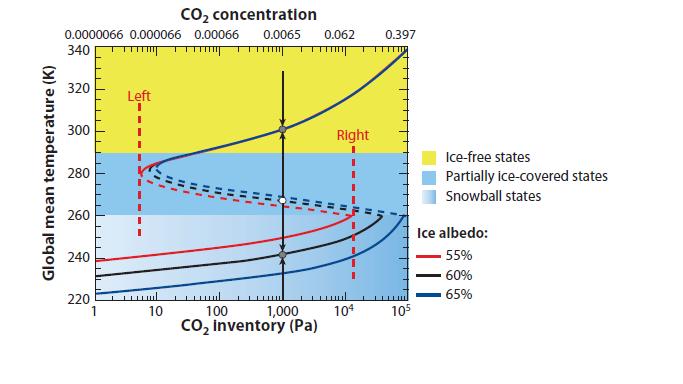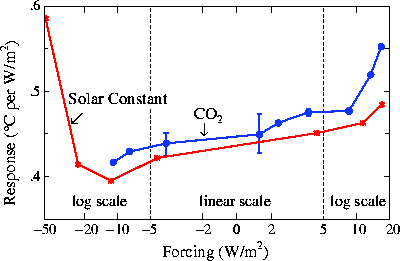What would a CO2-free atmosphere look like?
Posted on 11 March 2011 by Chris Colose
The ability for CO2 to warm the surface of a planet through the absorption of infrared radiation is well known. What is much less appreciated, however, is just how effective of a gas it is in maintaining the greenhouse framework that helps to characterize the modern climate.
The question of how the climate would change in a completely CO2-free atmosphere was brought up recently in a testimony to the subcommittee of the House Science and Technology Committee. An answer was provided by MIT scientist Dr. Richard Lindzen, who suggested that such a hypothetical removal of all the CO2 in the air would translate into a global cooling of about 2.5 degrees, presumably in Celsius (see here, about 47 minutes into the video). Dr. Cicerone, who was also on the panel, expressed disagreement although didn't really provide a better answer of his own.
It may be that Lindzen was just giving an estimate off the top of his head in a hearing, but the question is nonetheless interesting to explore further because it provides perspective on how to decompose the greenhouse effect into its individual components and the underlying implications of having a mixture of both condensing (i.e., those that reach saturation values and precipitate from the air) and non-condensing greenhouse gases. On Earth, water (which is radiatively active as a gas or a cloud) is the only condensable substance in the atmosphere, while the "long-lived" greenhouse gases (mostly CO2, CH4, O3, or N2O) do not precipitate from the air under modern temperature or pressure regimes.
One might naively suggest that removing all the CO2 in the atmosphere would produce a similar temperature change as doubling CO2, just in the other direction. Even without considering the complex nature of feedbacks, this conclusion would be wrong however. The radiative forcing generated by CO2 change goes as the logarithm of the concentration, and thus removing the whole CO2 inventory would generate a much larger impact than had you doubled it. In fact, when you get to very small amounts of CO2 (on the order of a few parts per million), the radiative forcing is much faster than logarithmic since you’re opening up new opacity in the central 15 micron band where Earth is strongly emitting (it is for this reason methane changes are commonly cited as being “more powerful than CO2,” which is only true molecule-for-molecule in the modern atmosphere, as methane is starting off at much lower background concentrations. Methane has no intrinsic properties that make this the case, and when comparing with CO2 side-by-side is even worse of a greenhouse gas).
Even this qualitative reasoning might have led Lindzen to a better ballpark answer than just 2-3 C, which would be even too small if feedbacks were completely neutral. It’s still qualitative however, and getting a better handle on the question requires radiative transfer modeling and simulations that can adequately handle a greenhouse-free atmosphere without blowing up. From here, the first question one can ask is how much of the total greenhouse effect is provided by CO2? This is dependent on the background atmosphere itself, since overlapping absorption with other molecules will give a different number than if that molecule were all by itself, even at the same concentration. When you do these calculations with overlapping absorption, it was found by Schmidt et al (2010) that CO2 contributes to about 20% of the modern greenhouse effect. The greenhouse effect can be defined energetically as:
![]()
where Ts and Te are the surface (288 K) and emission temperature (255 K), respectively. σ is the Stefan-Boltzmann constant. It follows that CO2 alone provides nearly 30 W/m2 of radiative forcing, much larger than the ~4 W/m2 when you double it in the modern climate. Assuming the same climate sensitivity, Lindzen’s estimate of a 2.5°C drop for a -30 W/m2 forcing would imply that currently doubling CO2 would warm the planet by only a third of a degree at equilibrium, which is well outside the bounds of IPCC estimates and even very low by most skeptical standards.
At this point, we need to incorporate feedbacks into the problem in order to get a better feel for how nature really operates. It is often mentioned as a somewhat routine talking point that “water vapor is the most important greenhouse gas.” This is true in the sense that it makes up the bulk of the infrared opacity in our atmosphere (~50%, and clouds another 25%), but because it condenses at Earth-like temperatures is very short-lived in the air as it goes through the evaporation, condensation, and precipitation cycle. Because of the temperature-dependency on the pressure at which water saturates, this makes water vapor a feedback. Another interpretation would then be that the non-condensing greenhouse gases (chiefly CO2, only about 5% of the greenhouse effect is provided by ozone, methane, N2O, etc) are the “most important,” since they provide enough warming so as to produce the skeleton by which the water vapor greenhouse effect can be strong enough.
There have been a number of studies which examine the evolution of the climate system with no CO2 in the atmosphere. Such experiments are described for example in Pierrehumbert et al (2007) , or by Voigt and Marotzke (2009). From these papers, one can trigger a full snowball Earth with a sufficient reduction in atmospheric CO2. A substantial reduction in water vapor (shown below, from Lacis et al (2010) as well as increase in the surface albedo are important feedbacks here, showing that removing the non-condensing greenhouse gases (mostly CO2) in the atmosphere can collapse nearly the entire terrestrial greenhouse effect. What’s more, since the albedo increases substantially, the total greenhouse effect can be thought of as providing even more than 33 K of warming relative to Earth’s blackbody emission temperature. In the Lacis et al experiments, removing the CO2 from the atmosphere generates a cooling of around 30 C, an order of magnitude difference from Lindzen's answer.

Figure 1: Time evolution of global surface temperature, TOA net flux, column water vapor, planetary albedo, sea ice cover, and cloud cover, after zeroing out all of the noncondensing GHG’s. From Lacis et al (2010)
Why might we care about such a hypothetical situation anyway? Aside from Lindzen, there are a number of interesting applications to low solar or low CO2 cases. A concern with “large” climate changes (i.e., on the scale of snowball Earths or runaway greenhouses) is that there’s bifurcation (loosely, tipping points) in the system. This is to say that one can conceivably draw down CO2 from the atmosphere and trigger a snowball, although it would take extremely high values of CO2 (much higher than the original amount) to get back out of this glaciated state. In case skeptics bring it up, this is at least one way to have an ice-covered planet with very high CO2 levels. Indeed, precisely how to escape a full-blown snowball is one of the grand unresolved questions in climate science.
Once you're out of a snowball however, you're left with a very hot climate until weathering can draw down CO2 to moderate values. Shown below (from Pierrehumbert et al., 2011, accepted) is a bifurcation sketch of the temperature as a function of the CO2 content in the atmosphere, with a lower solar insolation than today (specifically, Neoproterozoic insolation). One can do a similar type of diagram against the incoming shortwave radiation, but in any case the presence of an albedo feedback makes multiple temperature solutions possible, even for the same incoming stellar radiation and greenhouse effect. For example, if the Earth were magically ice-covered today, this would be a completely stable situation and there would be no tendency to escape that state unless the greenhouse effect was substantially enhanced or the sun got brighter. This is a big problem in planetary habitability studies, especially if a planet succumbs to a snowball fate early in its history when the sun is faint. Once you begin to melt ice however, the temperature jumps rapidly to a very hot solution.
This is germane to a recent paper by Rosing et al (2010) which purported to show that the "faint sun" paradox can be resolved through a lower albedo rather than through a substantially enhanced greenhouse effect. This paper is interesting, and an example of good scientific skepticism, in the sense that the authors are proposing a new idea for a subject still open for research. The idea is problematic however, since even for Neoproterozoic insolation, you kick over into a snowball at about 3x present CO2, and the situation is even worse for early Earth insolation, which is some 20-25% lower than today. There is no mechanism to adjust the albedo in such a way as to offset temperature changes, whereas the long-term silicate weathering thermostat acts as a negative feedback between CO2 concentations and temperature over geologic time.

Figure 2: Bifurcation diagram for a zero-dimensional energy balance model. Calculations performed with L = 1,285Wm−2. For CO2 inventories up to approximately 1,000 Pa, the inventory can be converted to a mixing ratio in parts per million by volume (ppmv) by multiplying by 6.6. The CO2 concentrations on the upper horizontal axis are stated as fractions (e.g., 0.0065 corresponds to6,500 ppmv). The vertical dashed lines marked “Left” and “Right” indicate the left and right boundaries of the hysteresis loop for the case with ice albedo equal to 55%. Adopted From Pierrehumbert et al., 2011, accepted
Lindzen has argued for a relatively insensitive climate system in the past, in which case it would be difficult to explain the magnitude of large climate changes in the past, ranging from snowballs, the PETM, glacial-interglacial cycles, etc. However, arguing that the climate would cool only be 2.5 degrees when you remove all the CO2 in the atmosphere is really just a made up number and ignored several articles on the subject that show otherwise. Just the opposite, evidence shows that CO2 provides the building block for the terrestrial greenhouse effect, both because it absorbs strongly near the peak emission for Earth, and because it allows Earth to be warm enough to sustain a powerful water vapor greenhouse effect.































 Arguments
Arguments























 0
0  0
0
 If we consider the minimum value only, that would indicate a fall in temperature after feedbacks of 14.6 degrees C for the total removal of CO2 from the atmosphere. That is likely way to small a reduction, as shown in the post above. However, it is a best case for Lindzen and shows him to have an error of 83% at minimum.
An alternative approach would be to compare climate sensitivities determined from geological data for warm and hot periods. As it happens, climate sensitivities determined for the LGM and for the Pliocene (cold and warm periods respectively) are very similar; as indeed are sensitivities determined using GeocarbSulf by Berner for the whole phanerozoic.
Regarding the "not at all subtle references", they are too subtle for me. All I know is that TTT are the initials of you chosen name.
If we consider the minimum value only, that would indicate a fall in temperature after feedbacks of 14.6 degrees C for the total removal of CO2 from the atmosphere. That is likely way to small a reduction, as shown in the post above. However, it is a best case for Lindzen and shows him to have an error of 83% at minimum.
An alternative approach would be to compare climate sensitivities determined from geological data for warm and hot periods. As it happens, climate sensitivities determined for the LGM and for the Pliocene (cold and warm periods respectively) are very similar; as indeed are sensitivities determined using GeocarbSulf by Berner for the whole phanerozoic.
Regarding the "not at all subtle references", they are too subtle for me. All I know is that TTT are the initials of you chosen name.







Comments